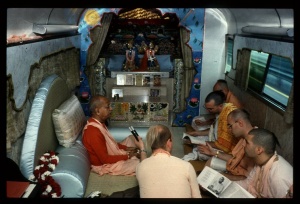CC Adi 17.16 (1975)

A.C. Bhaktivedanta Swami Prabhupada
Below is the 1996 edition text, ready to be substituted with the 1975 one using the compile form.
TEXT 16
- tabe nityānanda-gosāñira vyāsa-pūjana
- nityānandāveśe kaila muṣala dhāraṇa
SYNONYMS
tabe—thereafter; nityānanda—Nityānanda; gosāñira—of the Lord; vyāsa-pūjana—worshiping Vyāsadeva or the spiritual master; nityānanda-āveśe—in the ecstasy of becoming Nityānanda; kaila—did; muṣala dhāraṇa—carrying a plowlike weapon called a muṣala.
TRANSLATION
Nityānanda Prabhu then arranged to offer Vyāsa-pūjā, or worship of the spiritual master, to Lord Śrī Gaurasundara. But Lord Caitanya carried the plowlike weapon called muṣala in the ecstasy of being Nityānanda Prabhu.
PURPORT
By the order of Śrī Caitanya Mahāprabhu, Nityānanda Prabhu arranged for the Vyāsa-pūjā of the Lord on the night of the full moon. He arranged for the Vyāsa-pūjā, or guru-pūjā, through the agency of Vyāsadeva. Since Vyāsadeva is the original guru (spiritual master) of all who follow the Vedic principles, worship of the spiritual master is called Vyāsa-pūjā. Nityānanda Prabhu arranged for the Vyāsa-pūjā, and saṅkīrtana was going on, but when He tried to put a garland on the shoulder of Śrī Caitanya Mahāprabhu, He saw Himself in Lord Caitanya. There is no difference between the spiritual positions of Lord Caitanya Mahāprabhu and Nityānanda Prabhu, or Kṛṣṇa and Balarāma. All of Them are but different manifestations of the Supreme Personality of Godhead. During this special ceremony, all the devotees of Lord Caitanya Mahāprabhu could understand that there is no difference between Lord Caitanya and Nityānanda Prabhu.